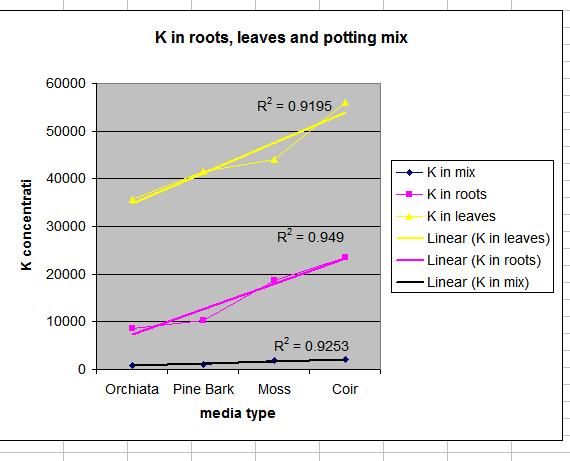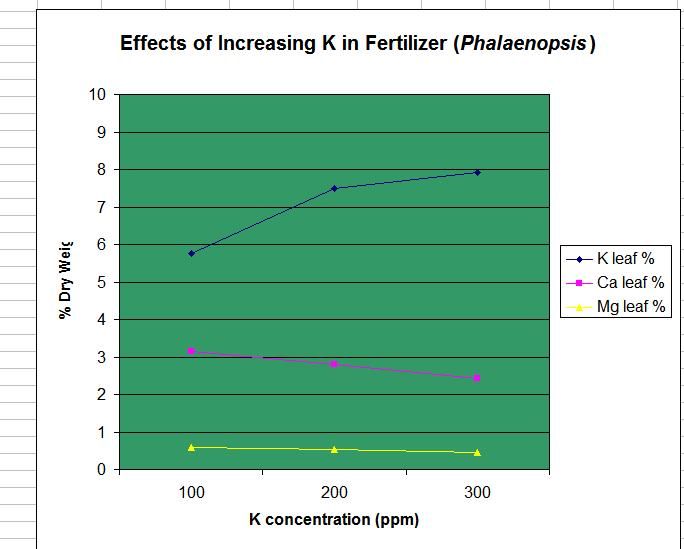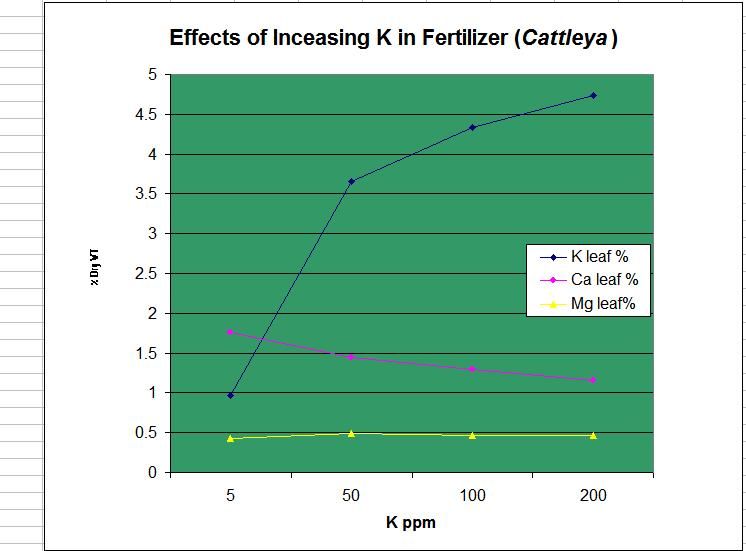So far, to make a reply over the whole thread:
- The background of those studies is simple. Many growers are using Orchiata and NZ Sphagnum moss around the world. Those are the majority of the growers in Hawaii and Japan in fact. Growers made a lot of internal trials, especially the pot plant growers, and at the end said that they are using Orchiata or NZ Sphagnum moss because their own results were far superior to the other potting mixes. Good. However some growers said that, as an example, plants in the Dutch mixes were growing very fast, then stopped growing after a while. Some other growers need technical advise to change from, let's say, fir bark (yes, some still do use it on a very large scale) to Orchiata. So we needed to have a background for the real differences, in terms of chemistry and growth, assessment. It is not a advertisement campaign at all...
- As for studies being paid by private companies, well, most studies in this world are, directly or indirectly. Many universities and research teams will do the studies in a fair way ( they have to water Orchiata or fir bark when the moisture content is such and such, etc...), so even if they know where are the Orchiata plant, they don't care, and no one can change or tamper the results. Add to that that New Zealand is one of the least corrupt countries in the world as well. I cannot think of any studies made by universities that are not done for commercial applications, or for private companies/on behalf of them/sponsored. Public money is rarely used for such studies, and the money involved is usually not spent on orchids, in that Pacific Wide did sponsor the study, to get chemical data information.
- I am technical adviser for Besgrow, indeed, and that's not a secret. I shared those results here pertaining to the potassium level. Rick found out that in Cornell they had even higher values, and no toxicity noticed at the end of their trial so far. I think the Cornell values are too excessive however, but indeed there are no 'toxic' effects.
- The results would be that people must not be afraid of potassium as an evil evenement, and the low K benefit lies mostly in a problem due to the use of an all nitrate fertilizer. In fact we found that the all nitrate fertilizer does not perform well at all. I cannot disclose more, because some are our customers for pot plant, including non phalaenopsis and quite fragile plants ( miltoniopsis), but indeed they tried nitrate as a source of nitrogen, with Orchiata, with NZ Sphagnum moss, even with coir, and even with mixes not related to Besgrow. I advised them all, and they are really huge nurseries, some of the biggest even. Their problems vanished as soon as they added ammonium. Strong, long lasting plants.
- Floricultura is growing a lot of mother plants, including masdevallias, paphs ( they have a very large collection, trust me, with some dream plants...), and many more. They apply the same feeding schedule for those as for their pot plants. Superb plants, some being decades old.
- Gonewild said * Over the years all different combinations of Nitrogen has been tried but no one really tried decreasing the potassium so low before. This was because science said we need high K levels for healthy plant growth. (results of university trials funded by fertilizer companies)*
Well, I agree that the high K formulations such as the 15-10-30 and such are not promoting anything good... However, not all different combinations of nitrogen have been tried, etc... over the years. Only very few, and it was a butchered job.
In Europe, we had nurseries with 40-50 years old plants. Using TAP water ( high in calcium), nitric acid to lower the pH, and an ammonium nitrogen source. The fertilizers used ( Hakaphos and similar...) were cheap ones, but included magnesium. There was actually nitrogen, ammonium, calcium, magnesium. Great plants. Floricultura used that feeding schedule.
Then, many nurseries changed for ALL their plants to using lime, and still an urea or ammo-urea fertilizer. Great plants. In fact many nurseries in Europe had a growth far superior to the US nurseries of the same time. names like Wichmann in Celle, Floricultura themselves, but Rohl, etc... had amazing growths.
The trials and university trials went from a NPK like a Peters, all urea, used in reverse osmosis water, and no calcium/magnesium found anywhere, to using an all nitrate calcium magnesium fertilizer, through various things, that were missing some elements.
As Ray pointed out, it is clear that the plant metabolism is not really a stupid ion uptake. Plants with lime ( I showed the Orchiata ones, but we had in the trial a Dutch blend with lime, and the calcium was really increased) always have much calcium in their tissues than plants supplemented with calcium nitrate. This is really weird...
Now I agree that Rick solved the MSU problem, and his solution is indeed good. I worry, myself, and I suggest to use a slightly higher potassium value, because different levels of potassium at the roots did not make a sharp increase in the leaves, and we failed to see anything that could be locked up, WITH THE USE of an urea/ammonium/calcium nitrate/magnesium sulfate fertilizer. That fertilizer produced stunning plants compared to the MSU.
According to my experience as a grower ( and not really a bad one

) I strongly advise to have much more ammonium. Why no one wants to make a test...
I think in fact that the seaweed could help a bit with the amino acids, too, and clearly I have seen improvement using seaweed on the plants. One of the best ( the best ?) growers of paphs I ever saw was using fern roots (don't tell me I am making the promotion of Orchiata), big charcoal, polystyren, seaweed and bat guano. Never seen before or since such massive plants... No mineral fertilizers, and the plants were really old.
As for what's a good growing plant, I would say that if the plant grows at the same speed or faster than in the wild, glossy juicy leaves but not weak or soft, then that's a good growing plant...
I am not really impressed by most of what is published in terms of feeding schedules or results. In fact, I sometimes advised growers to use this and that kind of recipe for their crop. Sometimes they made foliar or run off analysis ( some are big hydroponics growers), and the lab comments ' too much' 'not enough' blabla... Even some graphs show an arrow outside of the page, because the value is way too high. Well they have one of the best crop possible, so they have a big laugh, so do I.
Back to the main problem, potassium toxicity was not found to be a problem in general, and the plant clearly takes up what it needs up to a certain point.
I think however that ammonium would be a very welcome additive to the K Lite, as well as the use of lime in the potting mix with a 50-50 ammonium-nitrate nitrogen source. There are other unpublished results from the study, and my experience on top of that.
The potassium levels in our study were about half the ones of Cornell ( what the hell did they use ???), and this shows even further than potassium is not toxic through accumulation. It could be that, using a nitrate nitrogen fertilizer, a problem appears due to the potassium, but on a general sense, there is no problem.
My trials with MSU or the K Lite, ( and the ones of several massive nurseries, some having got real problems with the MSU type fertilizers, and even the calcium nitrate use vs. using lime in the potting mix...) were a total failure, compared to the growth standard I expect, dark green leaves, no premature leaf drop, increase in size, long roots, and long lasting, not weak or soft plants.
In our study too, the plants with the lower K content had higher contents of sodium and lithium... so it seems that those three guys can be interchanged. Maybe Rick low K pushes more sodium in the plant ( this is not detrimental, plants need sodium anyway... and plants can be deficient in sodium clearly), or??? But definitely not a K toxicity problem per se.
I use a lot of insecticides, being in Vietnam, but so far most of the plants did not get fungicide for a really long while, despite the weather. If the plants are growing well, they are less prone to diseases.
The easiest way for some people to test would be to add ammonium nitrate to the K Lite and see how the plants performs after that. I am certain that they would grow tremendously better ( and not soft or forced after that...). Several people on the forum already reported so, with the use of urea or ammonium and a K Lite variation home made... Some others reported the same with MSU and ammonium added too.






